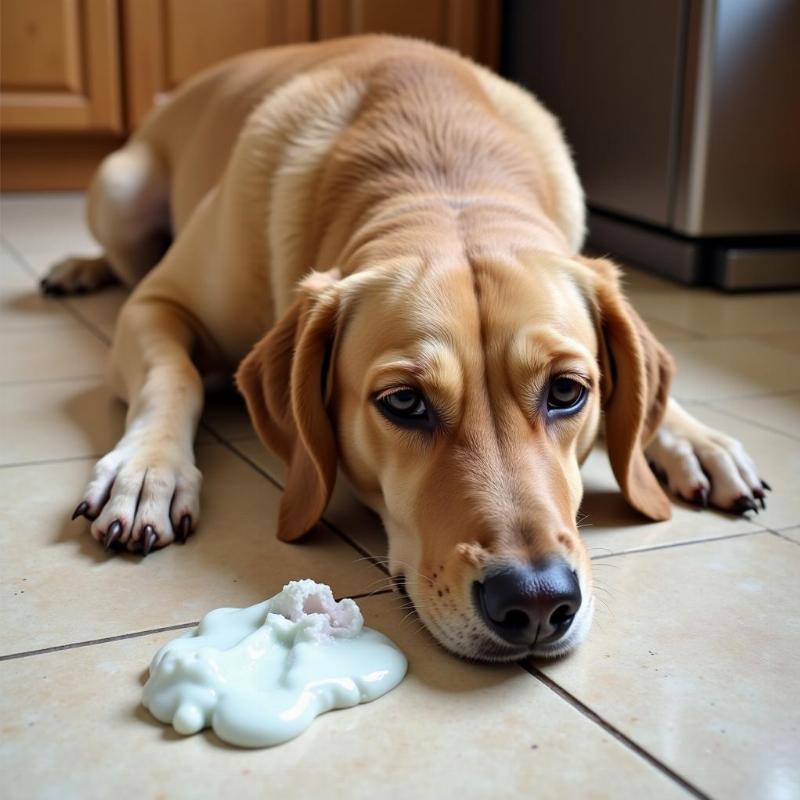Slime, a popular toy among children, can pose a potential danger to dogs. While most slimes are not inherently toxic, certain ingredients and the dog’s reaction to ingesting it can create serious health problems. This article will explore the potential dangers of slime for dogs, the symptoms of slime ingestion, and what you should do if your dog eats slime. We’ll also discuss preventative measures and safe alternatives for sensory play that won’t put your furry friend at risk.
Understanding the Risks of Slime for Dogs
The primary risk of slime for dogs comes from its ingredients. Many store-bought slimes and even some homemade recipes contain borax, a cleaning agent that can cause gastrointestinal upset in dogs. Even small amounts of borax can lead to vomiting, diarrhea, and excessive drooling. In larger amounts, borax poisoning can cause more severe symptoms like tremors, seizures, and even kidney failure. Another ingredient of concern is glue, which can cause blockages in the digestive tract. While many slimes use PVA glue, which is considered relatively non-toxic, the large amounts ingested by a dog can still create problems.
Signs Your Dog Ate Slime
If your dog eats slime, you should monitor them closely for any signs of distress. Common symptoms of slime ingestion include:
- Vomiting
- Diarrhea
- Loss of appetite
- Lethargy
- Drooling
- Abdominal pain
In more severe cases, you might observe:
- Tremors
- Seizures
- Difficulty breathing
- Kidney failure
What to Do if Your Dog Eats Slime
If you suspect your dog has ingested slime, contact your veterinarian immediately. The sooner you seek professional help, the better the outcome for your dog. Try to determine how much slime your dog ate and what ingredients it contained. This information will help your vet determine the best course of action. Do not induce vomiting unless instructed to do so by your veterinarian.
 Dog Vomiting
Dog Vomiting
Preventing Slime-Related Accidents
The best way to protect your dog from the dangers of slime is to keep it out of their reach. Store slime in a secure location, preferably in a locked cabinet or high shelf. Supervise children playing with slime, and ensure they understand the importance of keeping it away from pets.
Safe Alternatives for Sensory Play
There are many safe and engaging alternatives to slime that you can offer your children. Consider sensory bins filled with dry pasta, beans, or rice. Play-Doh is another option, though it should also be kept away from pets due to its high salt content. You can also make homemade slime using dog-friendly ingredients like cornstarch and water.
Is homemade slime safe for dogs?
Even homemade slime can be harmful if it contains ingredients toxic to dogs. Avoid using essential oils, borax, or other cleaning products in your homemade slime recipes.
Can scented slime harm my dog?
Scented slime often contains essential oils, some of which can be toxic to dogs. Even small amounts of certain essential oils can cause liver damage, respiratory problems, and other serious health issues.
What should I do if my dog ate a large amount of slime?
If your dog ingests a large amount of slime, seek immediate veterinary attention. Large quantities of slime can cause blockages in the digestive tract and lead to serious complications.
Conclusion
While slime can be a fun and engaging activity for children, it poses potential risks to our canine companions. By understanding these risks, recognizing the symptoms of slime ingestion, and taking preventative measures, we can ensure our dogs’ safety and well-being. Remember to keep slime out of reach, supervise children during playtime, and opt for safer alternatives whenever possible. If you suspect your dog has eaten slime, contact your veterinarian immediately.
FAQ
- What are the most common signs of slime poisoning in dogs? Vomiting, diarrhea, lethargy, and drooling are common signs.
- What ingredients in slime are toxic to dogs? Borax and certain essential oils are particularly harmful.
- Can my dog die from eating slime? In severe cases, especially with large amounts of borax ingestion, complications can be life-threatening.
- Is all slime toxic to dogs? While most slimes aren’t acutely toxic, the ingredients and a dog’s reaction can create health problems.
- What are some safe alternatives to slime for children? Sensory bins with dry ingredients, Play-Doh (supervised), and dog-friendly homemade slime are good alternatives.
- Should I induce vomiting if my dog eats slime? Only do so if instructed by your veterinarian.
- What information should I give my vet if my dog eats slime? The type of slime (store-bought or homemade), ingredients, and the estimated amount ingested are crucial information for your vet.
Beautdogs.us is your premier resource for all things dog-related in the US. We offer expert advice on dog breeds, care, and products, catering to both new and experienced dog owners. We strive to be the trusted source for comprehensive and engaging information on canine companionship and care. Contact us at [email protected] or +1 501-555-7529 for more information. Beautdogs.us is here to help you navigate the joys and responsibilities of dog ownership.